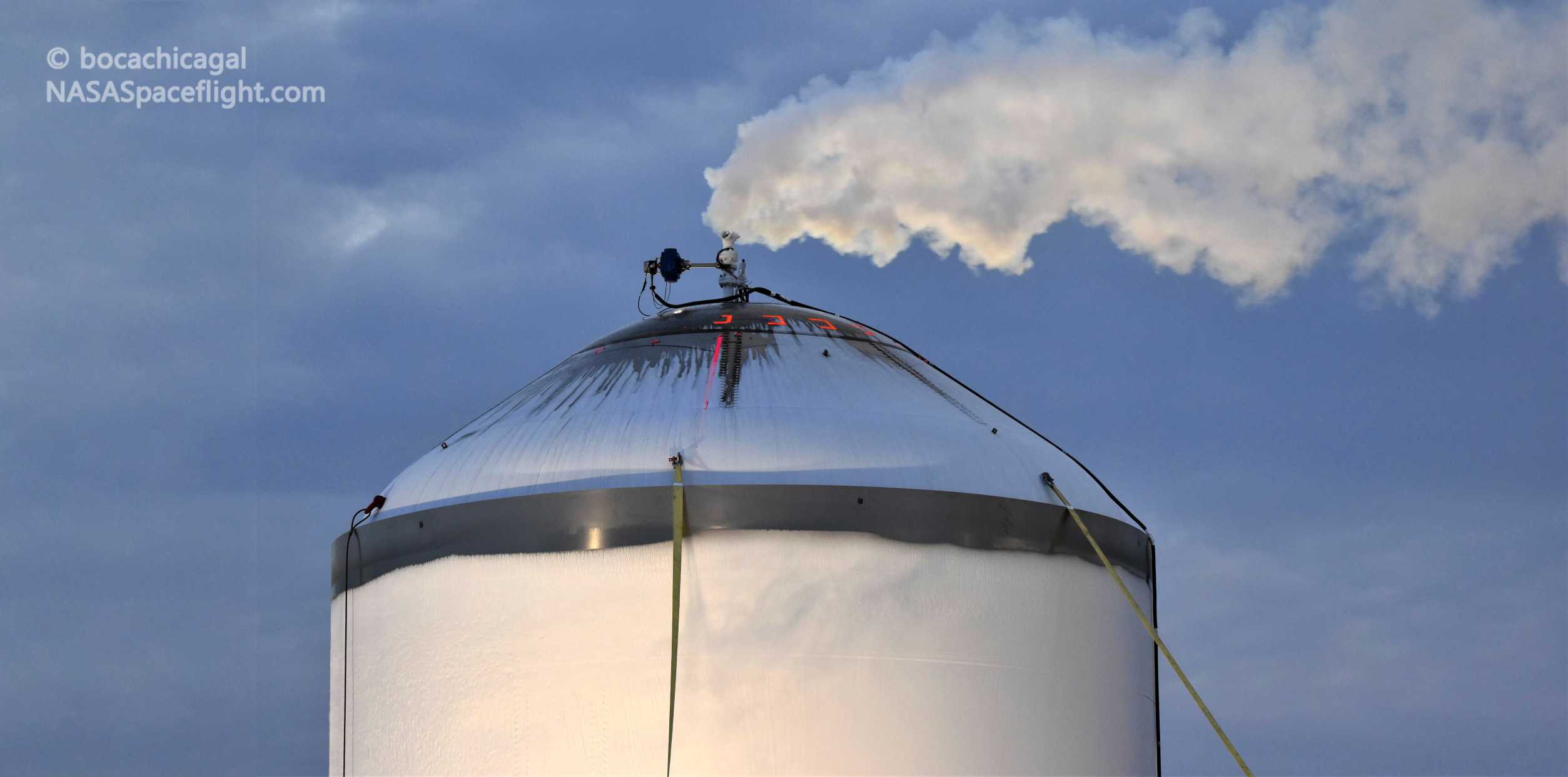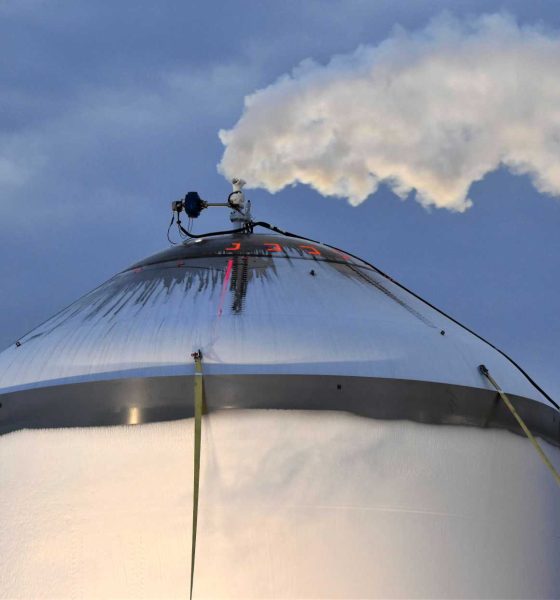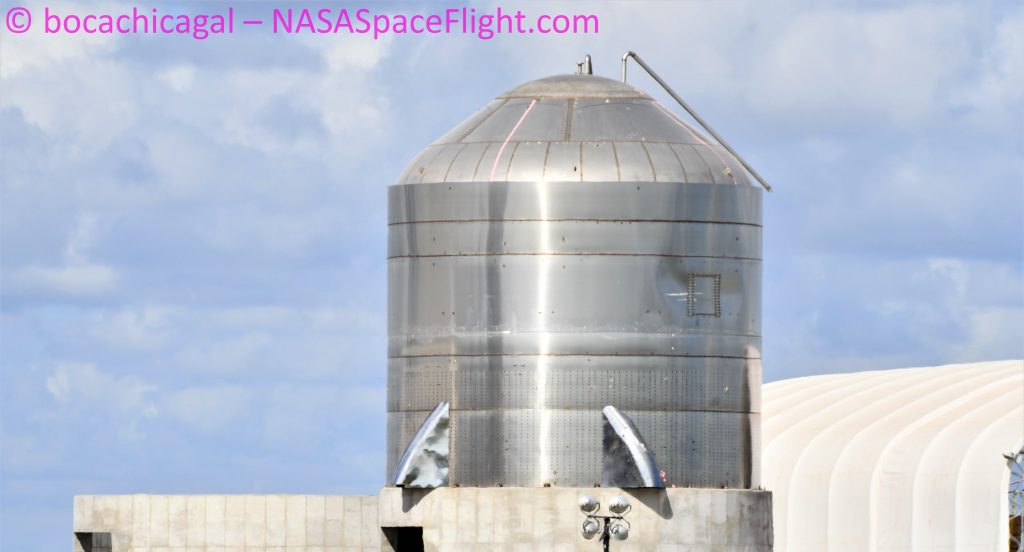

News
SpaceX Starship test tank survives first two nights of stress testing
SpaceX’s newest Starship test tank has survived the first two nights of stress testing, pushing the steel tank one step closer to a destructive finale.
Known as Starship SN7.1, the new tank – aside from one critical difference – is similar to Starship SN2 (pictured above), a full-scale prototype SpaceX repurposed into a test tank in March 2020. SN2 served to test improvements made to the design of Starship’s “thrust puck,” a dense steel cone that must transmit the thrust of three Raptor engines through the rest of the rocket. Much like SN2, SN7.1 is a test tank with a focus on the behavior of Starship’s engine section under extreme loads at cryogenic temperatures.
Unlike SN2, however, SN7.1 is built almost entirely out of a new steel alloy – closer to 304L than the 301 stainless used on all previous prototypes.


SpaceX rolled the tank to the launch site and pressurized it with cryogenic liquid nitrogen on September 10th as part of a routine “cryo proof” acceptance test. SN7.1 appeared to complete that proof without issue, exhibiting no leaks or unusual behavior, and likely reached pressures of 7.5-8 bar (~110-120 psi) before detanking.
Over the next three days, SpaceX inspected the test tank, relocated it to a more capable (and expensive) test stand, and connected hydraulic rams (used to mechanically simulate engine thrust) to its thrust puck.

Around midnight on September 15th, SpaceX kicked off the first round of SN7.1 stress testing, repeatedly loading and unloading the tank with liquid nitrogen. While it’s impossible to visually confirm the use of the stand’s hydraulic rams, it’s safe to assume that SpaceX used them to stress SN7.1’s thrust puck while chilled to cryogenic temperatures. The new steel alloy SpaceX is using on SN7.x and prototypes SN8 and beyond is designed to be less brittle at cryogenic temperatures, nominally ensuring that flawed or aged Starship tanks leak before they burst or explode.
Aside from the obvious triple-Raptor thrust simulation, SpaceX likely also simulated thrust from one or two Raptors to verify the new design’s ability to survive asymmetric thrust in engine-out scenarios. Ultimately, SN7.1 made it through the night without obvious issues and there have been no signs of leak-fixing today, suggesting that the tank performed well. SpaceX has a second SN7.1 test period scheduled to begin on September 17th, as well as backups on the 15th, 16th, 20th, and 21st. More likely than not, SN7.1’s next test will end when the tank is intentionally pressurized to failure.
Update: SpaceX has kicked off another night of SN7.1 stress testing, beginning almost as soon as the nine-hour window opened (9pm CDT (UTC-5) on September 15th). As of midnight, the company has already put the test tank through one cycle, rapidly filling and pressurizing it with liquid nitrogen before detanking. It remains to be seen if the company will continue testing this window, which closes at 6am on Wednesday. There is also a chance that SpaceX will intentionally pressurize SN7.1 to failure tonight, although it’s much more likely that the tank will be returned to a cheaper, simpler transport stand rather than risking damage to a new launch mount.
Check out Teslarati’s Marketplace! We offer Tesla accessories, including for the Tesla Cybertruck and Tesla Model 3.

News
Tesla FSD fleet is nearing 7 billion total miles, including 2.5 billion city miles
As can be seen on Tesla’s official FSD webpage, vehicles equipped with the system have now navigated over 6.99 billion miles.

Tesla’s Full Self-Driving (Supervised) fleet is closing in on almost 7 billion total miles driven, as per data posted by the company on its official FSD webpage.
These figures hint at the massive scale of data fueling Tesla’s rapid FSD improvements, which have been quite notable as of late.
FSD mileage milestones
As can be seen on Tesla’s official FSD webpage, vehicles equipped with the system have now navigated over 6.99 billion miles. Tesla owner and avid FSD tester Whole Mars Catalog also shared a screenshot indicating that from the nearly 7 billion miles traveled by the FSD fleet, more than 2.5 billion miles were driven inside cities.
City miles are particularly valuable for complex urban scenarios like unprotected turns, pedestrian interactions, and traffic lights. This is also the difference-maker for FSD, as only complex solutions, such as Waymo’s self-driving taxis, operate similarly on inner-city streets. And even then, incidents such as the San Francisco blackouts have proven challenging for sensor-rich vehicles like Waymos.
Tesla’s data edge
Tesla has a number of advantages in the autonomous vehicle sector, one of which is the size of its fleet and the number of vehicles training FSD on real-world roads. Tesla’s nearly 7 billion FSD miles then allow the company to roll out updates that make its vehicles behave like they are being driven by experienced drivers, even if they are operating on their own.
So notable are Tesla’s improvements to FSD that NVIDIA Director of Robotics Jim Fan, after experiencing FSD v14, noted that the system is the first AI that passes what he described as a “Physical Turing Test.”
“Despite knowing exactly how robot learning works, I still find it magical watching the steering wheel turn by itself. First it feels surreal, next it becomes routine. Then, like the smartphone, taking it away actively hurts. This is how humanity gets rewired and glued to god-like technologies,” Fan wrote in a post on X.
News
Tesla starts showing how FSD will change lives in Europe
Local officials tested the system on narrow country roads and were impressed by FSD’s smooth, human-like driving, with some calling the service a game-changer for everyday life in areas that are far from urban centers.

Tesla has launched Europe’s first public shuttle service using Full Self-Driving (Supervised) in the rural Eifelkreis Bitburg-Prüm region of Germany, demonstrating how the technology can restore independence and mobility for people who struggle with limited transport options.
Local officials tested the system on narrow country roads and were impressed by FSD’s smooth, human-like driving, with some calling the service a game-changer for everyday life in areas that are far from urban centers.
Officials see real impact on rural residents
Arzfeld Mayor Johannes Kuhl and District Administrator Andreas Kruppert personally tested the Tesla shuttle service. This allowed them to see just how well FSD navigated winding lanes and rural roads confidently. Kruppert said, “Autonomous driving sounds like science fiction to many, but we simply see here that it works totally well in rural regions too.” Kuhl, for his part, also noted that FSD “feels like a very experienced driver.”
The pilot complements the area’s “Citizen Bus” program, which provides on-demand rides for elderly residents who can no longer drive themselves. Tesla Europe shared a video of a demonstration of the service, highlighting how FSD gives people their freedom back, even in places where public transport is not as prevalent.
What the Ministry for Economic Affairs and Transport says
Rhineland-Palatinate’s Minister Daniela Schmitt supported the project, praising the collaboration that made this “first of its kind in Europe” possible. As per the ministry, the rural rollout for the service shows FSD’s potential beyond major cities, and it delivers tangible benefits like grocery runs, doctor visits, and social connections for isolated residents.
“Reliable and flexible mobility is especially vital in rural areas. With the launch of a shuttle service using self-driving vehicles (FSD supervised) by Tesla in the Eifelkreis Bitburg-Prüm, an innovative pilot project is now getting underway that complements local community bus services. It is the first project of its kind in Europe.
“The result is a real gain for rural mobility: greater accessibility, more flexibility and tangible benefits for everyday life. A strong signal for innovation, cooperation and future-oriented mobility beyond urban centers,” the ministry wrote in a LinkedIn post.
News
Tesla China quietly posts Robotaxi-related job listing
Tesla China is currently seeking a Low Voltage Electrical Engineer to work on circuit board design for the company’s autonomous vehicles.

Tesla has posted a new job listing in Shanghai explicitly tied to its Robotaxi program, fueling speculation that the company is preparing to launch its dedicated autonomous ride-hailing service in China.
As noted in the listing, Tesla China is currently seeking a Low Voltage Electrical Engineer to work on circuit board design for the company’s autonomous vehicles.
Robotaxi-specific role
The listing, which was shared on social media platform X by industry watcher @tslaming, suggested that Tesla China is looking to fill the role urgently. The job listing itself specifically mentions that the person hired for the role will be working on the Low Voltage Hardware team, which would design the circuit boards that would serve as the nervous system of the Robotaxi.
Key tasks for the role, as indicated in the job listing, include collaboration with PCB layout, firmware, mechanical, program management, and validation teams, among other responsibilities. The role is based in Shanghai.
China Robotaxi launch
China represents a massive potential market for robotaxis, with its dense urban centers and supportive policies in select cities. Tesla has limited permission to roll out FSD in the country, though despite this, its vehicles have been hailed as among the best in the market when it comes to autonomous features. So far, at least, it appears that China supports Tesla’s FSD and Robotaxi rollout.
This was hinted at in November, when Tesla brought the Cybercab to the 8th China International Import Expo (CIIE) in Shanghai, marking the first time that the autonomous two-seater was brought to the Asia-Pacific region. The vehicle, despite not having a release date in China, received a significant amount of interest among the event’s attendees.








